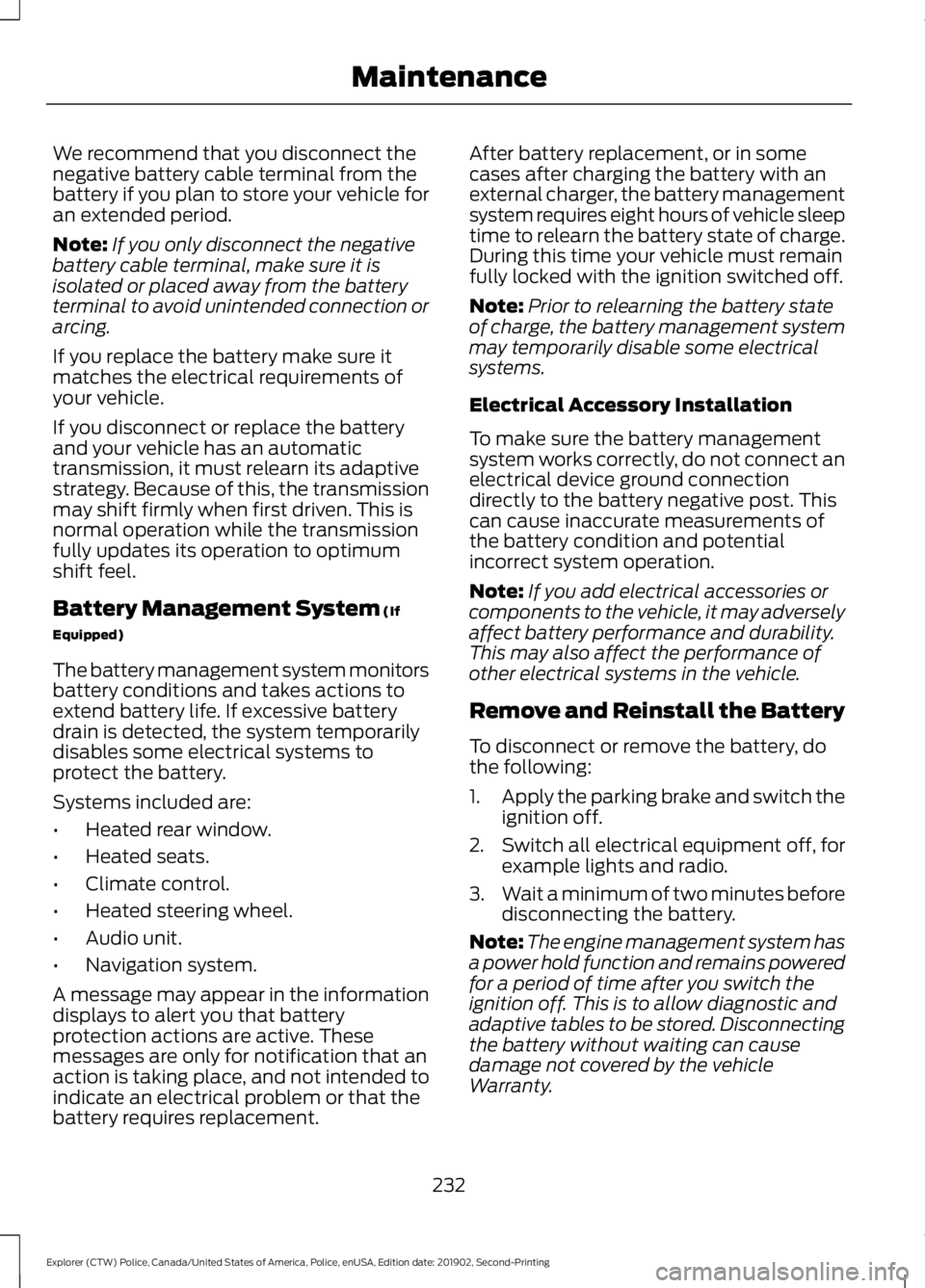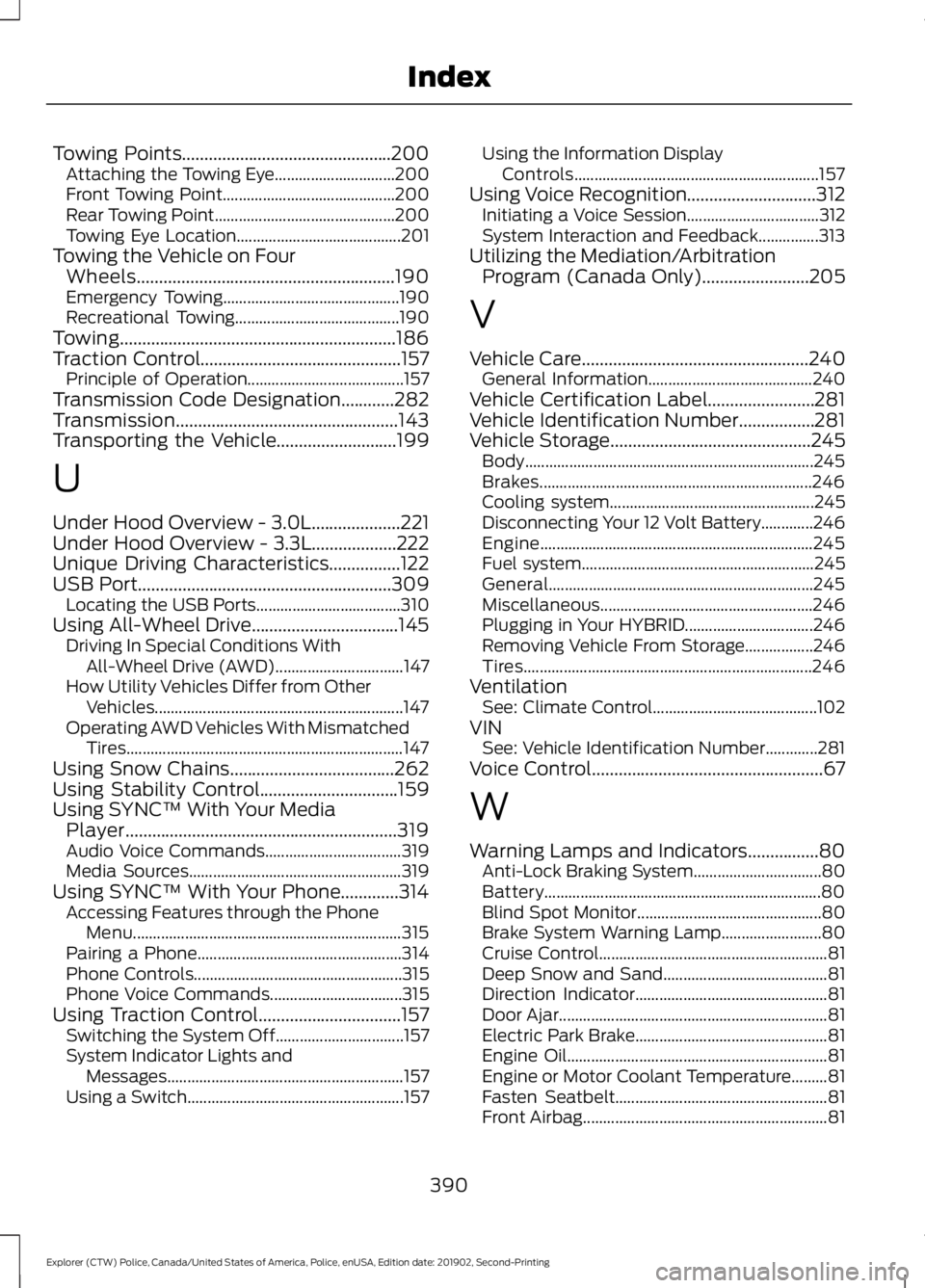2020 FORD POLICE INTERCEPTOR lights
[x] Cancel search: lightsPage 217 of 395

Protected Component
Fuse Rating
Fuse or Relay
Number
Delay accessory power.
10A
134
Not used (spare).
20A
136
USB smart charger 2.
5A
139
Traffic cam.
5A
142
Battery electronic control module.
15A
146
Left-hand headlamp module.
30A
148
Right-hand headlamp module.
30A
149
B+ feed.
40A
150
Transmission control module (hybrid
electric vehicle).
25A
155
DC/DC converter (hybrid electric vehicle).
15A
159
B+ feed.
10A
160
Front warning lights.
Strobes.
Low voltage service disconnect.
20A
168
Coolant pump (hybrid electric vehicle).
10A
169
Traction battery coolant pump (hybrid
electric vehicle).
10A
170
Not used (spare).
10A
177
Note: Spare fuse amperage may vary.
Passenger Compartment Fuse
Panel
The fuse panel is under the instrument
panel to the left of the steering column. Note:
It may be easier to access the fuse
panel if you remove the finish trim piece.
214
Explorer (CTW) Police, Canada/United States of America, Police, enUSA, Edition date: 201902, Second-Printing Fuses
Page 235 of 395

We recommend that you disconnect the
negative battery cable terminal from the
battery if you plan to store your vehicle for
an extended period.
Note:
If you only disconnect the negative
battery cable terminal, make sure it is
isolated or placed away from the battery
terminal to avoid unintended connection or
arcing.
If you replace the battery make sure it
matches the electrical requirements of
your vehicle.
If you disconnect or replace the battery
and your vehicle has an automatic
transmission, it must relearn its adaptive
strategy. Because of this, the transmission
may shift firmly when first driven. This is
normal operation while the transmission
fully updates its operation to optimum
shift feel.
Battery Management System (If
Equipped)
The battery management system monitors
battery conditions and takes actions to
extend battery life. If excessive battery
drain is detected, the system temporarily
disables some electrical systems to
protect the battery.
Systems included are:
• Heated rear window.
• Heated seats.
• Climate control.
• Heated steering wheel.
• Audio unit.
• Navigation system.
A message may appear in the information
displays to alert you that battery
protection actions are active. These
messages are only for notification that an
action is taking place, and not intended to
indicate an electrical problem or that the
battery requires replacement. After battery replacement, or in some
cases after charging the battery with an
external charger, the battery management
system requires eight hours of vehicle sleep
time to relearn the battery state of charge.
During this time your vehicle must remain
fully locked with the ignition switched off.
Note:
Prior to relearning the battery state
of charge, the battery management system
may temporarily disable some electrical
systems.
Electrical Accessory Installation
To make sure the battery management
system works correctly, do not connect an
electrical device ground connection
directly to the battery negative post. This
can cause inaccurate measurements of
the battery condition and potential
incorrect system operation.
Note: If you add electrical accessories or
components to the vehicle, it may adversely
affect battery performance and durability.
This may also affect the performance of
other electrical systems in the vehicle.
Remove and Reinstall the Battery
To disconnect or remove the battery, do
the following:
1. Apply the parking brake and switch the
ignition off.
2. Switch all electrical equipment off, for
example lights and radio.
3. Wait a minimum of two minutes before
disconnecting the battery.
Note: The engine management system has
a power hold function and remains powered
for a period of time after you switch the
ignition off. This is to allow diagnostic and
adaptive tables to be stored. Disconnecting
the battery without waiting can cause
damage not covered by the vehicle
Warranty.
232
Explorer (CTW) Police, Canada/United States of America, Police, enUSA, Edition date: 201902, Second-Printing Maintenance
Page 335 of 395

Check Every Month
Engine oil level.
Function of all interior and exterior lights.
Tires (including spare) for wear and proper pressure. Windshield washer fluid level.
Holes and slots in the tail pipe to make sure they are functional and clear of debris. Check Every Six Months
Battery connections. Clean if necessary.
Body and door drain holes for obstructions. Clean if necessary. Cooling system fluid level and coolant strength.
Door weatherstrips for wear. Lubricate if necessary.
Hinges, latches and outside locks for proper operation. Lubricate if necessary. Parking brake for proper operation.
Seatbelts and seat latches for wear and function.
Safety warning lamps (brake, ABS, airbag and seatbelt) for operation.
Washer spray and wiper operation. Clean or replace blades as necessary.
Multi-Point Inspection
In order to keep your vehicle running right,
it is important to have the systems on your
vehicle checked regularly. This can help
identify potential issues and prevent major
problems. We recommend having the
following multi-point inspection performed
at every scheduled maintenance interval
to help make sure your vehicle keeps
running great.
332
Explorer (CTW) Police, Canada/United States of America, Police, enUSA, Edition date: 201902, Second-Printing Scheduled Maintenance
Page 341 of 395

Driver Training/EVOC
Replace engine oil and filter as indicated by the information
display and perform services listed in the Extreme Usage
Scheduled Maintenance chart.
As required
Inspect brake pads, rotors, calipers hoses, and service as
required.
Inspect engine oil level.
Inspect vehicle every day
prior to starting training
Set tire pressure. Refer to driver door placard for cold tire
pressure information.
Inspect tire quality for wear.
Set wheel lug nut torque. The cold wheel lug nut torque
is 150 lb.ft (204 Nm). If wheels are torqued while they are
hot (after 15 minutes of EVOC driving), torque may be
checked to hot wheel lug nut torque of
70 lb.ft (95 Nm).
Proper functioning of safety devices (seat belts, no air bag
lights, etc.)
Front differential/axle fluid.
25 hours of training use
Rear differential/axle fluid.
100 hours of training use
Change transmission and transfer case fluids.
Annually
Note: Follow base owner guide direction
for 1,000-mile vehicle break-in prior to using
vehicle for training purposes.
Note: Incorporate vehicle cool-down after
hard driving.
Note: Perform Training / EVOC service
according to the Extreme Usage Scheduled
Maintenance chart.
Note: Use Police Interceptor part numbers
for replacement parts. Engine Idle Hour Meter
Your vehicle may have an idle meter to
indicate how much time the vehicle has
been sitting in park (P) or neutral (N). The
meter is incorporated with the vehicle
odometer. Depressing the odometer-reset
button once displays the trip odometer
(miles [kilometers] following by a "T" for
trip odometer); depressing the
odometer-reset button a second time
displays the idle meter (hours following by
an "H" for hours). The idle meter only
accumulates time while the vehicle is in
park (P) or neutral (N). Displayed time is
cumulative for the vehicle and cannot be
reset to zero. Police vehicles often
338
Explorer (CTW) Police, Canada/United States of America, Police, enUSA, Edition date: 201902, Second-Printing Scheduled Maintenance
Page 393 of 395

Towing Points...............................................200
Attaching the Towing Eye.............................. 200
Front Towing Point........................................... 200
Rear Towing Point............................................. 200
Towing Eye Location......................................... 201
Towing the Vehicle on Four Wheels..........................................................190
Emergency Towing............................................ 190
Recreational Towing......................................... 190
Towing..............................................................186
Traction Control.............................................157 Principle of Operation....................................... 157
Transmission Code Designation............282
Transmission..................................................143
Transporting the Vehicle...........................199
U
Under Hood Overview - 3.0L....................221
Under Hood Overview - 3.3L...................222
Unique Driving Characteristics................122
USB Port.........................................................309 Locating the USB Ports.................................... 310
Using All-Wheel Drive.................................145 Driving In Special Conditions With
All-Wheel Drive (AWD)................................ 147
How Utility Vehicles Differ from Other Vehicles.............................................................. 147
Operating AWD Vehicles With Mismatched Tires..................................................................... 147
Using Snow Chains.....................................262
Using Stability Control...............................159
Using SYNC™ With Your Media Player
.............................................................319
Audio Voice Commands.................................. 319
Media Sources..................................................... 319
Using SYNC™ With Your Phone.............314 Accessing Features through the Phone
Menu................................................................... 315
Pairing a Phone................................................... 314
Phone Controls.................................................... 315
Phone Voice Commands................................. 315
Using Traction Control................................157 Switching the System Off................................ 157
System Indicator Lights and Messages........................................................... 157
Using a Switch...................................................... 157Using the Information Display
Controls............................................................. 157
Using Voice Recognition.............................312 Initiating a Voice Session................................. 312
System Interaction and Feedback...............313
Utilizing the Mediation/Arbitration Program (Canada Only)........................205
V
Vehicle Care
...................................................240
General Information......................................... 240
Vehicle Certification Label........................281
Vehicle Identification Number.................281
Vehicle Storage
.............................................245
Body........................................................................\
245
Brakes.................................................................... 246
Cooling system................................................... 245
Disconnecting Your 12 Volt Battery.............246
Engine.................................................................... 245
Fuel system.......................................................... 245
General.................................................................. 245
Miscellaneous..................................................... 246
Plugging in Your HYBRID................................ 246
Removing Vehicle From Storage.................246
Tires........................................................................\
246
Ventilation See: Climate Control......................................... 102
VIN See: Vehicle Identification Number.............281
Voice Control
....................................................67
W
Warning Lamps and Indicators................80 Anti-Lock Braking System................................ 80
Battery..................................................................... 80
Blind Spot Monitor.............................................. 80
Brake System Warning Lamp......................... 80
Cruise Control......................................................... 81
Deep Snow and Sand......................................... 81
Direction Indicator................................................ 81
Door Ajar................................................................... 81
Electric Park Brake................................................ 81
Engine Oil................................................................. 81
Engine or Motor Coolant Temperature.........81
Fasten Seatbelt..................................................... 81
Front Airbag............................................................. 81
390
Explorer (CTW) Police, Canada/United States of America, Police, enUSA, Edition date: 201902, Second-Printing Index